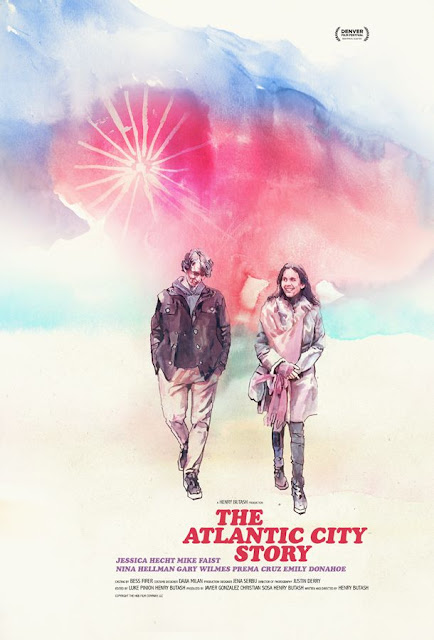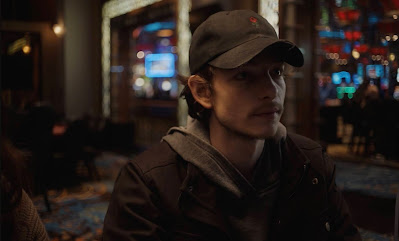 |
“Let the dead bury the dead, you shall leave no trace. Bury your existence, lest they say there lived a sufferer. The soul-less march of time has surrounded you, like an old cloth turned into a dry beetle. The (church) bells speak when people can’t. Little children cheer up. The dead buried their own dead. You will do so in future. You can hear the church bells under the water”
---words of a song sung in the opening sequence, where the time stamp is revealed by the electricity that lights up the room (the rest of the film is lit by candles). The song is sung, aided by a Lesiba, “an unbraced mouth resonated bow,” by the film’s actor Jerry Mofokeng
Lemohang Jeremiah Mosese is one of the best directors from the African continent today, if not a wider geographical area, and his 2019 film This Is Not A Burial, It's A Resurrection testifies that fact. How original is the tale of the film depends on whether he had seen a remarkable US film Northfork (2003) directed by Mark Polish with an original script written by the brothers Mark and Michael Polish. The essential similarity between the two are limited to the impending acquisition of land to make way for a man-made lake, the shadow of forcible relocation of the inhabitants of a town/village, a Christian priest (Nick Nolte, in the Polish film; Makhaola Ndebele in Mosese’s film) who provides spiritual succor, and relocation of buried remains of the dead before the waters are released. Both are remarkable films. In both films, we have inhabitants resisting change. In both films, the villagers/townsfolk battle powerful wealthy capitalist groups who promise a better life if the inhabitants agree to move out. Unlike Polish’s film that focused on diverse characters in a town, in Mosese’s film, the focus is on a single inhabitant--an 80-year-old widow named Mantoa (Mary Twala Mlongo, who is stunning in this film) mourning currently her son’s death and his burial. Similar to the work of the Polish brothers, there is a priest in Mosese’s film to comfort her spiritually but Mosese goes a step beyond the American film, he brings in sheep as non-human mourners in a twist of magic realism to comfort a widow whose house was once burnt in a fire that consumed all her possessions and, possibly, her bedridden husband. To capture the movement of the animals from an overhead shot was a masterstroke, reminding one of Terrence Malick’s shot of grazing wild bison surrounding the lead actors in To The Wonder (2012).
 |
| Mantoa played by Mary Twala Mlongo, who won 5 Best Actress Awards at various international film festivals for this role |
 |
| The opening song sung with a Lesiba (the room has electrical lights) |
Death and burial are important elements of spiritual and social discussion in This Is Not A Burial, It's A Resurrection. The film begins with Mantoa mourning the death of her son who had been working in a mine in neighboring South Africa, that landlocks Lesotho. The script of Mosese reveals in fits and starts that Mantoa has lost her bedridden husband, her daughter and her granddaughter. Her cumulative grief is relieved for a while by the consoling words of the Christian priest quoting the Bible passages. Yet this only leads to a crisis of faith in the strong Mantoa, who merely impassively listens to the hymn “Abide with me” sung in the local language by members of another burial procession passing by her hut. Mantoa is preparing for her own death and burial in the background of the imminent “death and burial” of her “weeping” village called Nasarethe (a variant of Nazareth, the town Jesus grew up in the Bible) under the waters of the proposed lake. Mantoa calls all the womenfolk of the village and gives guidelines on her own burial reminding one of Abbas Kiarostami’s quest for a suitable person to bury his fictional character Badil in the 1997 Golden Palm winner at Cannes, The Taste of Cherry. For Mantoa, her death is certain and around the corner and her burial wishes will be complied with; for Badil, his plan is dependent on future intangibles. Mosese presents Mantoa, a woman of strong will and character, a ‘Mother Courage,’ who pays a villager in advance to dig her grave next to her husband’s and son’s graves.
 |
| Mantoa grieves her losses to a fire sitting on a charred bed while sheep magically surround her as co-mourners |
 |
| After the fire, the rebuilt elegant hut of Mantoa (note the art direction/production design) |
Mosese’s film presents an unforgettable mix of script, visuals and sounds that are rarely captured so effectively and evocatively in a film. Almost every shot in the film, often wordless, express the affinity of Mantoa to her immediate surroundings that goes beyond the cemetery, the church with its well-described historic bell, and the dead bodies buried in the graves. The colorful attires of Mantoa indoors are regal and yet simple. The exterior shots silently describes the single individual swallowed up by the vast well-endowed land that produce useful flora for the humans and feed for the sheep, not to mention the rainwater that blesses the country.
 |
| Mantoa in mourning attire (note the candles.) |
 |
| Mantoa, in better times, (note the rich colors.) |
 |
| The typical cinematography of the film, accentuating Mantoa's stature against larger forces, of rainwater from the clouds that can bring prosperity and the cemeteries that will go under water |
Director Lemohang Jeremiah Mosese, as the director, screenplay writer and editor has made Lesotho and Africa proud with his second feature film winning plaudits all over the globe. African cinema is on the march while showing indirectly the effect of development in the region.
P.S. This Is Not A Burial, It's A Resurrection has won 20 awards worldwide at film festivals including Athens, Durban, Hong Kong, Kerala, Montreal, Reykjavik, Sundance, and Taipei international festivals. At the Kerala festival (IFFK) it was chosen the Best Film in competition. Five of these awards were for Mary Twala Mlongo as the Best Actress at the respective events. At IFFK, too, the late Mary Twala Mlongo earned a Special Mention. The film participated at the Denver film festival, This Is Not A Burial, It's A Resurrection is one of the author's best films of 2020. Mark Polish’s film Northfork (2003) and Terrence Malick’s To The Wonder (2012), mentioned above, have been reviewed earlier on this blog. (Click on the names of the films in the post-script to access the reviews.)





